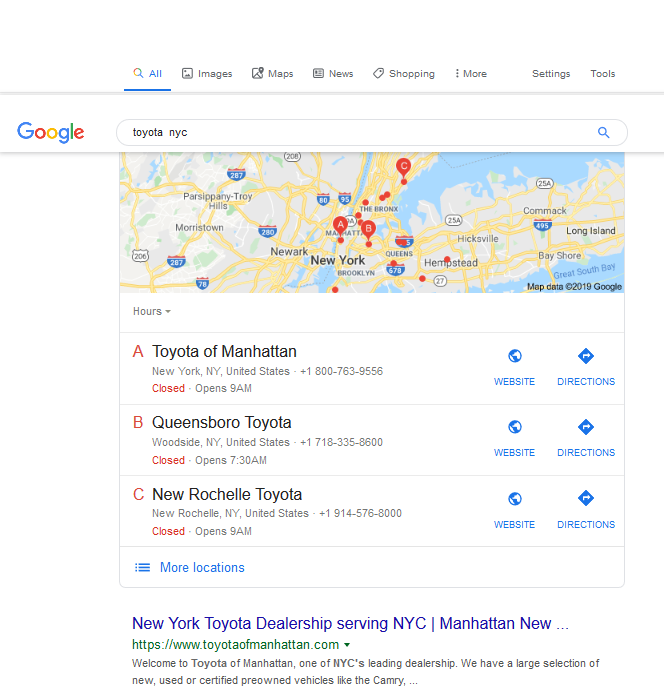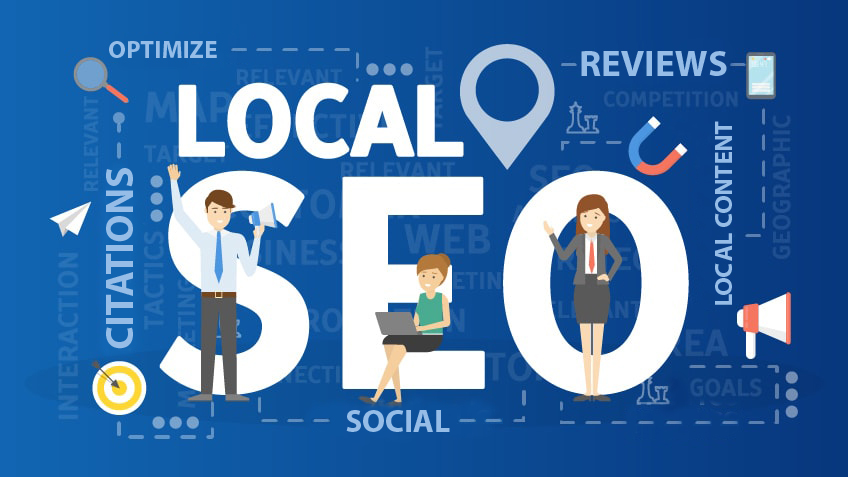Last Updated on October 31, 2019
Local SEO is important if you are a business or service provider.
There’s no denying that online searches are the major lead generator for local businesses. On Google, 46% of all searches are local.
For you, it means, if as a local business, you haven’t worked on your local SEO, you are missing a chance to generate revenue every time someone searches your product or service on Google.
If you think you are not missing a lot of opportunities, then think again. According to one study, around 89% of people search for local businesses on their smartphones once a week, while 58% of them searching daily. Out of these searchers, 72% will visit a local business within five miles radius.
That’s a lot of business to be losing due to poor local SEO. So, we might have got your attention now. Hence we can proceed to make you understand what local SEO is and how you can supercharge your online business with little bit adjustments.
What is local SEO?
Local SEO is just your good-old organic Search Engine Optimization just with an added geographical component. If you want to rank for local searches, your webpages and business listings must be optimized for the local searches.
When we say optimized for local searches, we mean optimized for the local market. A Texas restaurant has no business ranking high in New York. Just organic SEO will lead to such misplaced results, but with local SEO, you can increase organic traffic to your local business with high conversion.
According to Moz, one of the most important ranking factors for local SEO results is the proximity of the searcher.
Now here, we want to reveal the Google “3-pack”.
What is a three-pack?

The top three results for a local search are called the 3-pack that used to be a 7-pack, but Google truncated it for better mobile search experience.
The above is a 3-pack result for a local search, “Toyota NYC.”
This is the position you want your business to sit in.
And, how exactly do you get in there?
That is what this guide on local SEO is about.
Let’s get you in the top three in Google’s SERP.
-
Optimize your website for local SEO
If you are running an online business, then chances are you already have a solid SEO strategy in place. If not, then you have bigger problems to deal with. Read here why SEO audit is necessary and how you can do it.
Without an optimized website, it will be inevitably hard to rank in SERPs.
Once you get the standard SEO implemented, it’s time to work on local SEO.
Here’s how you optimize for local SEO:
Create a dedicated local contact page
People don’t want fancy business information, but they want detailed contact information about your business.
These days, people want more detailed information about your business. You must have the following information listed on your local contact page (NAP):
Name
Address
Phone
Now that’s standard practice, but not with businesses with multiple locations. If you have a presence across ten or fewer locations, mention NAP for all locations in the footer.
Also, make phone numbers and emails clickable for better experience on mobile devices. Almost 76% of local searches result in a phone call; this is why PHONE NUMBER MUST BE CLICKABLE.
Here’s what Google has to say for making phone numbers clickable.
Add a map or your locations
The premise of local SEO is that you are making your business easier to find. Adding a business location via a Google map will make your business easily findable. As 86% of the people look for businesses on Google Maps, you just cannot miss on this one.
Have testimonials on your website
Testimonials are a ‘trust signal’ that Google takes into account, but the on-page testimonials no longer work the same as they used to. Rather than encouraging customers to leave a review on your webpage, ask them to review your business on sites such as Trust Pilot, Google Reviews, BBB, Yelp, etc. Here’s a detailed post on updated review rich results.
Add Schema
Schema helps search engines to help them make sense of what your website is all about. The schema was designed to be a common language between Google, Yahoo, and Bing. Add appropriate schema to your local business website to let search engines know that you are a local business and not some big brand.
-
Claim your business profiles online
Your business website is not the online place on the internet where you must be found.
You have to set up a profile at all major platforms where customers flock for reviews and other users’ opinions about your business. You must have claimed your profile on Google My Business, Facebook, TripAdvisor, Yelp and Trust Pilot.
Also, don’t forget the popular local review sites, because often Google picks listing for its 3-pack from these local review sites.
Here’s a detailed guide from Google to request ownership of a business listing on Google My Business. Once you have your presence on Google My Business, searchers will be able to find you much more easily on Google Maps (remember 86% of people look at local businesses on Google Maps).
Also, cover all local listings like Yelp and TripAdvisor. Just search for sites that are relevant for your business using keywords:
Location + Reviews
Category + Reviews
And finally, lay claim over other social profiles to easily target the right demographics. To be successful with social profiles, consistency is the key. Always engage with the target audience and ask for their feedback.
-
Create local content
Content has always been the king, and it will remain the same.
Blogging is an essential part of SEO, which is why if you haven’t already created a blog for your business website, just do it!
Also, avoid hosting a blog on a subdomain like ‘blog.yourwebsite.com,’ instead host it on your business domain, i.e., ‘yourwebsite.com/blog.’
This is because, when you acquire links for the quality content you produce, you will also gain backlinks for your business site. Backlinks continue to be one of the major ranking factors for ranking higher.
Pay attention to include as much local information as you can in content. Add names of local cities and, more particularly, local neighborhoods, towns, and places for better local optimization.
Local news, community events, fairs, local organizations, reviews of local businesses, etc. all make for nice local content fodder.
BUT DON’T WRITE ABOUT YOUR PRODUCT OR SERVICE.
Why?
As David Meerman Scott puts it, “Stop talking about your products and services. People don’t care about products and services; they care about themselves.”
Write local content that benefits the reader in some way and aim to become a trusted source.
Build links
Standard or local SEO, you are reliant on backlinks to soar in the ranking. Generating inbound links is important but do it the right way. Participate in meaningful conversations, help the community with your knowledge, mention others in your blog posts and above all build relationships.
Know the customers
How can you expect to deliver any value to the customers without knowing them?
The first step towards helpful quality local content creation is creating readers’ personas, understanding target neighborhoods and the demographics.
Winding up, avoid some common local content pitfalls. First, don’t take content from other websites, that a lazy approach. Only attributed content can be part of the mix. Second, don’t take a multi-website approach to promote your business. Just build a single, quality, and strong website.
-
Ask and earn reviews
The Internet has made customers powerful enough to take on bad businesses. No longer can businesses dupe customers and get away with it unaffected.
Almost instantly, you can check whether a business is as good as it says it is. According to studies, 81% of people read reviews and ratings. Also, 97% of people agree that customer reviews factor into their final buying decision.
So, how your business’s online reviews are can make or break it.
Poor ratings can easily turn customers off, which is why anything below four or 5-star rating can put your business in a shady light. The absence of rating also instills doubt and discouragement towards a brand. According to a Harvard study, even bumping your rating by one star can increase revenue by 10%.
However, acquiring reviews is an ongoing process that you need to nurture. Every business gets negative reviews at some point, but when you do, always act professionally and respond personally. Providing an incredible service or product is the best way to garner positive reviews.
Also, Moz points out that Google reviews have the biggest impact on Google’s local rankings.
-
Build citations
Citations are the mentions of your business name, phone number, address, or website anywhere on the internet. These are important cause citations are believed to make up to 13% of the local pack-ranking factor.
Now before you start making citations for any business information, we recommend only use real physical locations like P.O. Boxes and regional offices. Know that virtual offices are not acceptable.
Again, consistency is the key.
Also, when using abbreviations in address, use the right ones. Here’s Whitespark’s complete table listing abbreviations that Google understands.
Local search engines such as TripAdvisor and Yelp, local blogs, locally-focused directories, and industry-focused directories or blogs will help build high-quality citations.
Local SEO Guide [Infographic]

Local SEO Guide For Small Businesses [Infographic]
With local SEO, you have the edge over big brands.
People are using search engines more and more to find local businesses, and you need to rank your local ranking to be found.
This five-step local SEO guide is all you need to a solid strategy to optimize your business to rank in local SERPs.

